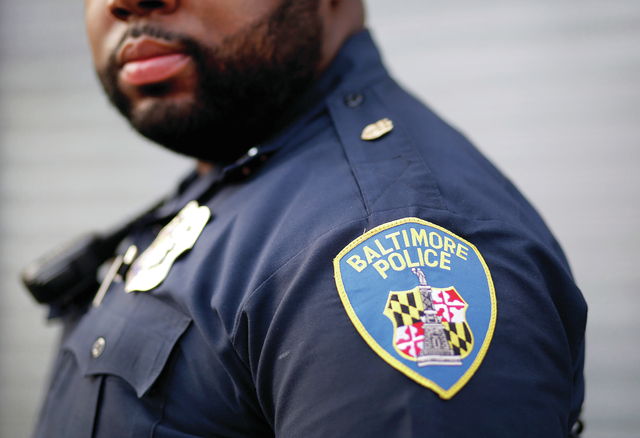Scathing report on Baltimore cops vindicates black residents

BALTIMORE — With startling statistics, a federal investigation of the Baltimore Police Department documents in 164 single-spaced pages what black residents have been saying for years: They are routinely singled out, roughed up or otherwise mistreated by officers, often for no reason.
ADVERTISING
The 15-month Justice Department probe was prompted by the death of Freddie Gray, the black man whose fatal neck injury in the back of a police van touched off the worst riots in Baltimore in decades. To many people, the blistering report issued Wednesday was familiar reading.
Danny Marrow, a retired food service worker, said that over the years, he has been stopped and hassled repeatedly by police.
“It started when I was 8 years old and they’d say, with no probable cause, ‘Hey, come here. Where are you going?’” he said. “No cause, just the color of my skin.”
“Bullies in the workplace,” he said. “They don’t want you to get angry or challenge their authority, so they’ll use force, they’ll put the handcuffs on too tight. And if you run, they’re going to beat you up when they catch you.”
The Justice Department looked at hundreds of thousands of pages of documents, including internal affairs files and data on stops, searches and arrests.
It found that one African-American man was stopped 30 times in less than four years and never charged. Of 410 people stopped at least 10 times from 2010 to 2015, 95 percent were black. During that time, no one of any other race was stopped more than 12 times.
With the release of the report, the city agreed to negotiate with the Justice Department a set of police reforms over the next few months to fend off a government lawsuit. The reforms will be enforceable by the courts.
Mayor Stephanie Rawlings-Blake and Police Commissioner Kevin Davis acknowledged the longstanding problems and said they had started improvements even before the report was completed. They promised it will serve as a blueprint for sweeping changes.
“Fighting crime and having a better, more respectful relationship with the community are not mutually exclusive endeavors. We don’t have to choose one or the other. We’re choosing both. It’s 2016,” said Davis, who was appointed after the riots in April 2015.
Six officers, three white and three black, were charged in Gray’s arrest and death. The case collapsed without a single conviction, though it did expose a lack of training within the department.
Calvin Void, 45, said Wednesday that he was once tackled by a police officer who was convinced he had just participated in a drug deal. But when the officer checked his pockets, he found no cash or drugs. Still, Void was arrested.
“He smacked me in the head with his walkie-talkie,” Void said, motioning to a patch of discolored skin on his scalp. “And he said if I reported him I couldn’t come around here anymore because he’d jump out and whip my ass. It made me frightened.”
Anthony Williams, a 27-year-old father raising young children in Sandtown-Winchester, the neighborhood where Gray was arrested, said he was once with his kids and saw officers chasing a teenager for smoking marijuana.
“There was five of them. They jumped on him. I had to tell my kids they were just playing,” he said.
The government report represented a damning indictment of how the city’s police officers carry out the most fundamental practices, including traffic stops and searches.
It found that officers make a large number of stops — mostly in poor, black neighborhoods — with dubious justification and unlawfully arrest citizens when officers “did not like what those individuals said.”
“These violations have deeply eroded the relationship between the police and community it serves,” Vanita Gupta, head of the Justice Department’s civil rights division, said at a news conference alongside the mayor and police commissioner.
The Justice Department has undertaken similar investigations of the police in Chicago; Cleveland; Albuquerque, New Mexico; and Ferguson, Missouri, among other cities.
Federal investigators interviewed Baltimore residents, police officers, prosecutors, public defenders and elected officials, rode along with police on duty and reviewed documents and complaints.
“Nearly everyone who spoke to us … agreed the Baltimore Police Department needs sustainable reform,” Gupta said.
Among other findings: Blacks account for 63 percent of the city’s population and roughly 84 percent of all police stops. From 2010 to 2015, officers stopped 34 black residents 20 times, and seven African-Americans 30 times or more.
In addition to pat-downs, Baltimore officers perform unconstitutional public strip searches, even of people not under arrest, the report said. It said officers routinely use unreasonable force, including against juveniles and people who aren’t dangerous.
The direction often came from the top: In one instance, a police supervisor told a subordinate to “make something up” after the officer protested an order to stop and question a group of young black men for no reason.
Baltimore police are trained in aggressive tactics that foster an “us vs. them mentality” toward the community, the report said.
Eugene O’Donnell, a former New York City police officer and a professor at the John Jay College of Criminal Justice, said the report failed to take into account the complicated realities of being a police officer in Baltimore.
“They have huge unresolved problems, huge festering problems,” O’Donnell said. “And the Justice Department has nothing to say about that at all.”
He said the Justice Department criticized officers for making unlawful stops, when “it’s absolutely impossible to articulate what is and what is not a lawful stop. It’s a minefield.”


